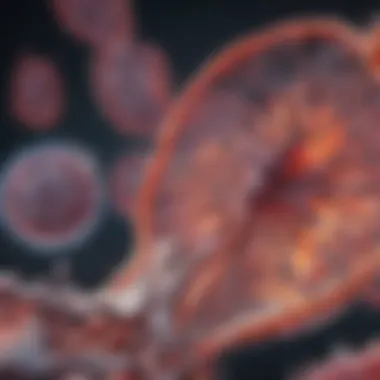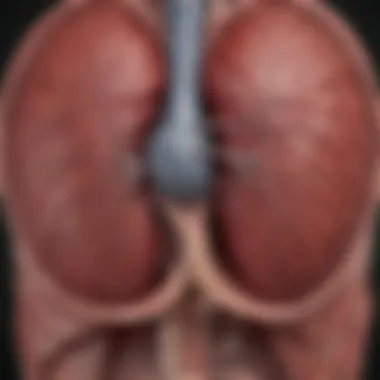Stages of Cardiac Amyloidosis: A Comprehensive Overview


Intro
Cardiac amyloidosis is a severe and progressively debilitating condition. This disease occurs due to the deposition of amyloid proteins in the heart tissue, which disrupts normal heart function. Understanding the stages of this condition is critical for effective diagnosis and management.
This article aims to delve deep into the various stages of cardiac amyloidosis, providing clarity on its physiological mechanisms, clinical manifestations, and diagnostic approaches.
Research Overview
Methodological Approaches
Research on cardiac amyloidosis incorporates various methods. Clinicians often utilize echocardiography and cardiac magnetic resonance imaging to assess structural changes in the heart. Blood tests are crucial for detecting amyloid deposits, especially troponin levels and N-terminal pro b-type natriuretic peptide (NT-proBNP). Biopsies may be conducted to confirm amyloid type. This multi-faceted approach ensures a comprehensive understanding of the condition.
Significance and Implications
The study of cardiac amyloidosis stages is significant for multiple reasons. By understanding the progression of the disease, healthcare providers can tailor interventions. For instance, earlier stages may be managed with lifestyle changes or medication, while advanced stages may necessitate more invasive treatments such as heart transplantation. Awareness of the disease's stages can significantly improve patient outcomes and quality of life.
Understanding the various stages of cardiac amyloidosis allows for tailored treatments that directly impact patient survival and wellness.
Current Trends in Science
Innovative Techniques and Tools
As research continues, innovative techniques emerge for diagnosing and treating cardiac amyloidosis. Recently, positron emission tomography (PET) scans have gained traction. These have proven effective in providing insights into amyloid deposits within the heart. Moreover, advancements in genetic testing allow for better understanding and management of hereditary forms of the disease.
Interdisciplinary Connections
The study of cardiac amyloidosis intersects various medical fields. Cardiologists, pathologists, and geneticists collaborate to enrich knowledge and improve treatment strategies. Such interdisciplinary connections foster a holistic approach to managing this multifaceted disease, emphasizing the need for diverse expertise in tackling complex health issues.
Prolusion to Cardiac Amyloidosis
Cardiac amyloidosis is a significant condition that warrants close examination due to its growing prevalence and complex nature. Understanding the different stages of this disease is essential for both clinicians and researchers. It ensures that patients receive timely diagnosis and targeted treatment. This article aims to delineate each stage, shedding light on clinical manifestations, diagnostic approaches, and management strategies associated with the progression of cardiac amyloidosis.
Definition and Overview
Cardiac amyloidosis refers to a group of conditions characterized by the abnormal accumulation of amyloid proteins in the heart tissue. Amyloid, which is an abnormal protein, can derive from various sources including immunoglobulins and serum amyloid A proteins. The deposition of these proteins disrupts normal cardiac structure and function. This condition can be classified into distinct types, mainly light-chain (AL) amyloidosis or reactive (AA) amyloidosis, among others. Each type has its own implications on patient outcomes and therapeutic options.
Pathophysiology of Amyloid Deposits
The pathophysiology of cardiac amyloidosis is a complex interplay between protein misfolding and cellular toxicity. Initially, the production of excessive amyloid precursor proteins leads to their aggregation. Once these proteins aggregate, they form insoluble fibrils that get deposited in the cardiac interstitium. This disrupts the normal contractile function of the heart muscle and can lead to restrictive cardiomyopathy. As amyloid deposits increase, the heart becomes stiffer, leading to impaired diastolic filling and eventually heart failure. Moreover, inflammatory processes may also play a role in the progression of this disease, complicating the clinical landscape.
Importance of Staging
The staging of cardiac amyloidosis is crucial for several reasons. Primarily, it enables healthcare professionals to stratify the risk associated with disease progression. Understanding the stage of the disease aids in determining appropriate treatment strategies, tailoring interventions to the patient’s specific needs and condition. Each stage presents unique symptoms and challenges, thus emphasizing the need for precise diagnostic criteria and management plans. Additionally, knowledge of staging helps in predicting patient prognosis, allowing for timely and informed decision-making in clinical practice.
"The staging of cardiac amyloidosis guides therapeutic approaches and optimizes patient care."
Classification of Cardiac Amyloidosis
Classification of cardiac amyloidosis is crucial for understanding the disease's multifaceted nature. Different forms of amyloidosis have unique origins, pathophysiological features, and implications for treatment. Recognizing which type of amyloidosis is present can guide appropriate management strategies, prognosis, and potential therapeutic responses. This section reviews the major classifications of cardiac amyloidosis, each representing a distinct pathway of amyloid protein deposition and its effects on cardiac function.
Primary (AL) Cardiac Amyloidosis
Primary amyloidosis, or light-chain amyloidosis (AL), arises from the abnormal production of immunoglobulin light chains by plasma cells. This overproduction can occur in conditions such as multiple myeloma. In AL amyloidosis, these light chains misfold and aggregate into amyloid fibrils that deposit in various organs, primarily the heart, causing structural and functional changes. Clinical features often include restrictive cardiomyopathy, leading to symptoms like dyspnea and edema.
Diagnosis typically involves:
- Serum and urine protein electrophoresis to detect light chains.
- Tissue biopsy to confirm amyloid deposits using Congo red staining.
- Imaging studies, such as echocardiography, to assess cardiac involvement.
Management focuses on targeting the underlying plasma cell disorder with chemotherapeutic agents like bortezomib and melphalan.


Secondary (AA) Cardiac Amyloidosis
Secondary amyloidosis, or AA amyloidosis, is associated with chronic inflammatory conditions, such as rheumatoid arthritis or chronic infections. In this form, the protein amyloid A (from serum amyloid A) is produced in excess due to ongoing inflammation. The amyloid A protein then misfolds and leads to deposition in various organs, including the heart. Symptoms may mirror those of primary amyloidosis but are closely linked to the underlying disease status.
Diagnosis often involves:
- Testing for inflammatory markers, alongside imaging to assess amyloid burden.
- Biopsy remains vital for confirmation.
Management strategies focus on treating the underlying condition to reduce inflammation, potentially leading to a decrease in amyloid burden over time.
Hereditary Cardiac Amyloidosis
Hereditary or familial amyloidosis is caused by genetic mutations that lead to the accumulation of amyloid proteins within the heart and other organs. Common types include transthyretin amyloidosis (ATTR), found in mutations related to the transthyretin protein. Patients may present with early-onset heart failure, neuropathy, and other systemic symptoms.
Diagnosis includes:
- Genetic testing for known mutations.
- Traditional diagnostic methods like biopsy and echocardiography remain essential.
Management often involves genetic counseling and treatments specifically targeting the misfolded protein, such as tafamidis or diflunisal, which stabilize the transthyretin protein.
Wild-type Cardiac Amyloidosis
Wild-type cardiac amyloidosis, also referred to as senile systemic amyloidosis, occurs due to age-related deposition of wild-type transthyretin protein. It primarily affects older men and often goes underdiagnosed as it can present similarly to other age-related heart conditions. The typical presentation includes heart failure and cardiac arrhythmias.
Diagnosis involves noninvasive imaging, especially echocardiography, along with blood tests to rule out other heart diseases.
Management may include general heart failure therapies, although specialized treatments are still being studied to target the destabilization of the transthyretin protein.
Understanding the classification of cardiac amyloidosis types is essential for targeted treatment and better patient outcomes.
Stages of Cardiac Amyloidosis
The stages of cardiac amyloidosis are crucial to understanding the progression of this complex disease. Each stage presents unique clinical features and challenges. Recognizing these stages improves diagnosis, informs treatment strategies, and helps predict outcomes. For patients, accurate staging can guide discussions regarding prognosis and potential therapies. This focus on stages allows for a more tailored and effective approach to patient management.
Initial Stage: Asymptomatic
Clinical Features
In the initial stage of cardiac amyloidosis, patients often present without any apparent symptoms. This asymptomatic phase can create a challenge for diagnosis as individuals may not recognize any issues with their health. Key characteristics include subtle changes in the heart that may be detected only through specialized testing. Early detection in this phase is critical because it may influence treatment choices later on. Though there are no overt symptoms, the absence of symptoms is a significant factor that clinicians monitor closely.
Biomarkers
Biomarkers like NT-proBNP and troponin can play a role in identifying the early accumulation of amyloid proteins. These biomarkers help to uncover potential cardiac involvement before major symptoms present. A notable feature of this phase is how subclinical changes can be tracked through biomarkers, making them a popular tool for early diagnosis in this article. However, practitioners should be cautious; relying solely on biomarkers without clinical correlation can lead to misinterpretation of the disease status.
Imaging Studies
Imaging studies such as echocardiography or cardiac MRI become important tools in the initial stage. These studies can reveal specific cardiac abnormalities that are characteristic of amyloidosis. One unique aspect of imaging studies is their ability to visualize subtle changes to heart structure and function. This helps differentiate cardiac amyloidosis from other forms of heart diseases, thus ensuring appropriate clinical intervention.
Moderate Stage: Symptoms Emerge
Cardiac Symptoms
As cardiac amyloidosis progresses to the moderate stage, patients may begin to experience symptoms such as fatigue, palpitations, and shortness of breath. The emergence of these symptoms indicates a significant shift in disease severity. A prominent characteristic of this stage is the increased awareness of individual health, which can motivate patients to seek medical attention. This can lead to timely intervention, but the management of symptoms becomes a priority in this stage.
Diagnostic Strategies
Diagnostic strategies, including comprehensive evaluations like family history, physical exams, and advanced imaging, become imperative. A key characteristic worth noting is how these strategies often combine multiple modalities to form a complete patient picture. This multi-faceted approach is beneficial for accurate diagnoses but can increase costs and complexity in care modeling.
Treatment Perspectives


At this stage, treatment perspectives may shift toward more active management of symptoms and underlying pathophysiology. Treatments may include medications, lifestyle adjustments, and tailored therapies focusing on symptom relief. The versatility of treatment plans at this stage represents a beneficial choice for clinicians wanting to provide holistic care. However, the diverse therapeutic avenues present the challenge of future outcomes and patient adherence to treatment regimens.
Advanced Stage: Heart Failure
Clinical Manifestations
In the advanced stage, clinical manifestations include severe heart failure symptoms such as edema, severe fatigue, and potentially life-threatening arrhythmias. This critical stage signifies a severe loss of cardiac function. The ability to recognize definitive signs of decompensation at this stage is crucial to delivering appropriate care. At this point, understanding manifestations can help spur immediate medical action, which is vital for improving outcomes.
Management Challenges
Management challenges become pronounced due to the comprehensive needs of patients experiencing heart failure. Issues like coordinating care among specialists and determining the best pharmacological options can complicate treatment. A characteristic challenge is balancing aggressive treatment with the risks of further complications or deteriorations. This duality shows how complex the management course is during this advanced stage.
Prognosis
The prognosis during this advanced phase is often guarded, as the likelihood of adverse outcomes increases significantly. Understanding prognosis involves assessing multiple individual factors, such as age, comorbidities, and response to treatment. A notable feature of prognosis at this stage is how information can vary widely among individuals, making clear communication essential for patient and caregiver understanding.
End-Stage: Palliative Care
End-of-life Considerations
In the end-stage, the focus of care typically shifts towards palliative measures. Discussions around end-of-life care become crucial. Significant elements in this phase involve addressing the values and wishes of the patient surrounding their care choices. Patients and families need support from healthcare providers as they navigate the difficult decisions ahead. The holistic approach in palliative care allows for comfort and respect of patient dignity, making it a compassionate option.
Patient Quality of Life
The quality of life becomes the priority focus during this stage. Interventions aimed at alleviating suffering, providing emotional support, and helping families cope with impending loss are vital. Key aspects of maintaining quality of life involve effective pain management and mental health resources. Broadly, this offers a balanced approach to dealing with the multiple layers of suffering present.
Supportive Therapies
Supportive therapies take various forms and can include physical therapy, psychological support, and nutritional guidance. Each therapy aims to enhance the overall experience as patients work through their condition. A defining feature of these therapies is their adaptability to meet individual patient needs, which can improve life quality. However, supportive interventions should always align with the patient’s goals and expectations, requiring careful and compassionate implementation.
"Understanding the stages of cardiac amyloidosis empowers both patients and providers. Tailoring care based on the stage can significantly influence management and outcomes."
These comprehensive explorations of the stages of cardiac amyloidosis reveal not only the complexity of the disease but also the critical need for nuanced understanding among healthcare providers and patients alike.
Diagnostic Approaches
Understanding the diagnostic approaches for cardiac amyloidosis is essential. This knowledge enables healthcare professionals to identify the disease early and implement appropriate interventions. Early diagnosis is critical to improve patient outcomes. Each diagnostic tool offers unique insights, allowing for a comprehensive assessment of the condition. The integration of various diagnostic methods is vital for accurate evaluation and treatment planning.
Electrocardiogram (ECG) Findings
The electrocardiogram is a fundamental tool in assessing cardiac amyloidosis. It serves to uncover characteristic features of the disease. An ECG may reveal abnormalities such as low-voltage QRS complexes, which are indicative of infiltrative processes within the myocardium. Arrhythmias, including atrial fibrillation, are also common findings in these patients. These ECG changes can guide clinicians in recognizing cardiac amyloidosis. Moreover, a detailed analysis of the ECG can help in stratifying patients according to their risk and comorbidities.
Echocardiography Insights
Echocardiography is a primary imaging modality in diagnosing cardiac amyloidosis. It provides real-time visualization of cardiac structure and function. Key findings include thickened left ventricular walls and diastolic dysfunction. These alterations are often subtle in the initial stages, making it crucial for radiologists to have a high index of suspicion. Echocardiography can also assess ventricular size and motion, helping differentiate cardiac amyloidosis from other forms of cardiomyopathy. The non-invasive nature of this method supports its widespread use in clinical practice.
Cardiac MRI Utilization
Cardiac magnetic resonance imaging (MRI) has emerged as a valuable adjunct in diagnosing cardiac amyloidosis. It allows for detailed visualization of cardiac tissues, highlighting areas of late gadolinium enhancement (LGE). This enhancement typically signifies amyloid deposits in the myocardium. The sensitivity of cardiac MRI to detect these changes is often superior to echocardiography. It can also assist in evaluating prognosis and tracking the response to therapies. Utilizing cardiac MRI may lead to better individual patient care through tailored treatment strategies.
Biopsy Techniques
Biopsy remains the gold standard for definitive diagnosis of cardiac amyloidosis. Various techniques can be employed, including endomyocardial biopsy and fat pad biopsy. Endomyocardial biopsy, while invasive, offers direct evidence of amyloid deposits in myocardial tissue. Conversely, fat pad biopsy is a less invasive method that can still yield valuable information. Immunohistochemistry is often utilized to confirm the type of amyloid protein present. Accurate identification of the amyloid subtype is critical, as it significantly influences treatment choices and prognostication.
In summary, employing a variety of diagnostic approaches enhances the ability to accurately diagnose and manage cardiac amyloidosis, ultimately improving patient outcomes.
Management of Cardiac Amyloidosis
The management of cardiac amyloidosis is crucial for improving patient outcomes and enhancing quality of life. This condition is characterized by the accumulation of amyloid proteins in the cardiac tissue, leading to heart dysfunction. Effective management strategies are necessary to address both the underlying causes of the disorder and the symptomatic effects on the individual. Given the heterogeneous nature of cardiac amyloidosis, management must be individualized according to the patient's stage of the disease and specific clinical characteristics.


Pharmacological Treatments
Pharmacological treatments play a key role in managing cardiac amyloidosis. The focus is often on both reducing amyloid production and alleviating symptoms.
- Chemotherapy: In cases of primary (AL) cardiac amyloidosis, chemotherapy is essential. Agents like cyclophosphamide and bortezomib help decrease the production of amyloid light chains.
- Targeted Therapy: Newer therapies, such as daratumumab, target specific immune cells to further reduce light chain levels.
- Heart Failure Management: Given the heart failure symptoms that can arise, the use of diuretics and beta-blockers is common. These help manage fluid overload and heart rate.
- Anticoagulants: In patients with atrial fibrillation, anticoagulants may be introduced to minimize the risk of thromboembolic events.
It is imperative for clinicians to monitor patients closely for adverse effects and adjust therapies as necessary.
Non-Pharmacological Approaches
Non-pharmacological approaches also hold substantial significance in the management of cardiac amyloidosis. These strategies can help optimize patient care and support better health outcomes.
- Lifestyle Modifications: Encouraging patients to adopt a heart-healthy lifestyle is fundamental. This includes dietary changes, regular exercise, and weight management to alleviate stress on the heart.
- Patient Education: Educating patients about their condition and engaging them in self-management increase awareness and compliance with recommended therapies.
- Support Groups: Participation in support groups can enhance emotional well-being and provide social support, which is especially important given the chronic nature of the disease.
Emerging Therapies
The field of cardiac amyloidosis management is evolving, with promising emerging therapies on the horizon. These innovative treatments aim to directly target the amyloid deposits or the underlying mechanisms of the disease.
- RNA Interference: Treatments such as patisiran utilize RNA interference technology to reduce the production of transthyretin, a protein implicated in hereditary forms of amyloidosis.
- Gene Therapy: Experimental approaches in gene therapy aim to correct the genetic defects causing amyloid production, potentially altering the course of disease.
- Monoclonal Antibodies: New monoclonal antibody treatments that target amyloid fibrils are being studied and could offer another layer of therapeutic options in the future.
As research advances, the therapeutic landscape for cardiac amyloidosis will continue to shift, hopefully translating into better outcomes for patients.
Prognosis and Outcomes
The prognosis and outcomes of cardiac amyloidosis play a crucial role in understanding this disease's trajectory. Knowing the prognosis helps both patients and healthcare providers make informed decisions about monitoring and treatment strategies. The complexity of cardiac amyloidosis and its varying stages means that the outcomes can significantly differ based on several factors, such as timely diagnosis, underlying amyloid type, and patient response to treatment. This section aims to explore the survival rates across different stages of cardiac amyloidosis and the key factors influencing prognosis.
Survival Rates Across Stages
The survival rates in cardiac amyloidosis are closely interfaced with the disease stage at which it is diagnosed. In the initial asymptomatic stage, many patients often have a reasonable prognosis, with survival rates exceeding five years for a significant number of them. However, as the disease progresses to the moderate and advanced stages, these rates decline sharply. Patients symptomatic with heart failure may face drastically reduced life expectancy, with median survivability ranging significantly from less than a year to some years, depending on various variables.
Recent studies have shown that:
- Asymptomatic Stage: Survival rates tend to be favorable, often 5-10 years.
- Moderate Stage: Life expectancy can reduce to around 2-5 years after the onset of significant symptoms, particularly heart-related ones.
- Advanced Stage: The life expectancy drops notably, with many patients surviving less than 1-2 years due to the severe nature of heart failure and related complications.
- End-Stage: Here, the prognosis shifts towards comfort and quality of life, with palliative care options predominating and survival decreasing to a few months or less, depending on the management of associated conditions.
"Understanding the prognosis at each stage is essential for effective patient management and decision-making."
Factors Influencing Prognosis
Several factors can alter the prognosis in patients with cardiac amyloidosis. These include:
- Type of Amyloidosis: Patients with primary light-chain (AL) amyloidosis often have worse outcomes compared to those with ATTR amyloidosis, primarily due to differences in disease aggressiveness and treatment response.
- Timeliness of Diagnosis: Early detection leads to better management strategies and improved prognoses. Delays can result in significant progression of cardiac damage.
- Secondary Conditions: The presence of other comorbidities, such as diabetes or renal dysfunction, can negatively impact patient outcomes.
- Response to Treatment: Individual response to available treatments, including novel therapies, can lead to better survival rates.
- Socioeconomic Factors: Access to healthcare and genetic aspects can vary according to geographical areas, affecting the overall outcomes for different populations.
Understanding these influencing factors allows for more effective clinical decisions and personalized patient care plans. Each aspect needs consideration to navigate the complexities of cardiac amyloidosis effectively.
Future Directions in Research
The exploration of future directions in research regarding cardiac amyloidosis is essential for advancing our understanding and treatment of this complex condition. As we gain more insights into the underlying mechanisms and consequences of amyloid deposits, researchers aim to develop innovative strategies for diagnosis and management. This section emphasizes the significance of identifying cutting-edge methods and therapies to improve patient outcomes.
Innovative Diagnostic Methods
Recent advancements in technology have paved the way for innovative diagnostic methods that hold promise for enhancing the accuracy and timeliness of cardiac amyloidosis identification. Early detection is pivotal, as it can significantly influence the course of treatment and prognosis for patients.
Some promising diagnostic approaches include:
- Novel Biomarkers: Research into specific amyloid proteins may yield new biomarkers that could be useful in diagnosing cardiac involvement. For example, the identification of unique peptides or proteins related to amyloidosis might help in distinguishing the type of amyloidosis and its impact on the heart.
- Advanced Imaging Techniques: Methods such as positron emission tomography (PET) and cardiac magnetic resonance imaging (MRI) are being explored for their enhanced capability to visualize amyloid deposits and assess cardiac function more accurately. These techniques may reduce the need for invasive procedures traditionally associated with diagnosis.
- Genomic and Proteomic Analyses: The integration of genomic and proteomic data could provide deeper insights into the molecular pathways involved in cardiac amyloidosis. By understanding these mechanisms, healthcare professionals could develop targeted diagnostic tests for better patient stratification.
These innovative diagnostic methods offer multiple benefits, such as reducing time to diagnosis, improving patient access to treatment options, and personalizing care plans that better address individual patient needs.
Therapeutic Developments
As research continues, therapeutic developments are crucial for managing cardiac amyloidosis effectively. While current treatment options provide some relief, there is a clear need for therapies designed to target amyloid deposits directly and mitigate their impact on cardiac function.
Key areas of therapeutic development include:
- Targeted Drug Therapies: New drugs, such as tafamidis, are being examined for their efficacy in stabilizing transthyretin, the main protein involved in hereditary forms of cardiac amyloidosis. Future medications could further enhance this principle or target other proteins associated with different types of amyloidosis.
- Gene Therapy Approaches: Research into gene editing technologies, such as CRISPR, may pave the way for potential cures by correcting genetic mutations that lead to amyloid production. This area is still in its infancy but holds transformative potential.
- Immunotherapy: There is growing interest in developing immunotherapies that can help the body more effectively clear amyloid deposits. By modulating the immune response, patients may experience slowed disease progression and improved heart function.
As these therapeutic developments unfold, they present considerable hope for enhancing the quality of life for individuals affected by cardiac amyloidosis. Continuous collaboration between researchers, clinicians, and patients will be vital in shaping a future where effective therapies are available.



